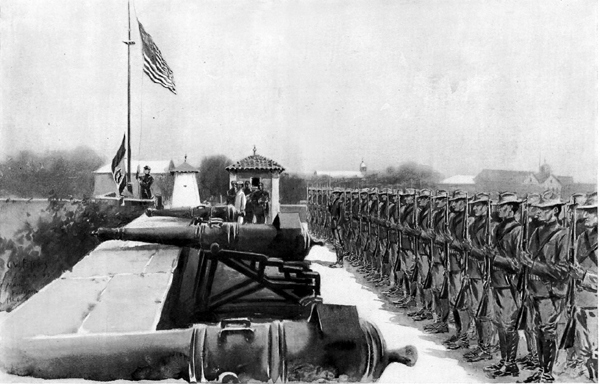
Raising the Flag over Ft. Santiago, Manila, August 13, 1898 drawn by G. W. Peters, special artist for
Harper's Weekly.
First Wyoming was stationed at Camp Dewey. Camp Dewey was located in a former peanut field near el Camino Real, the royal highway.
The Royal Highway was less than royal and was more of a muddy path.
Henry Lippincott, Deputy Surgeon General United State Army in the Jan. 1, 1899, Report of the Surgeon General of the United States
Army observed that shelter consisted of tents,but with the rainy season it was, he wtote necessary
for the men in pairs to:
[B]uy from the natives a framework of bamboo about 30 inches high, on which and over which the shelter tent made an apology for a covering.
Ponchos thrown over all kept out part of the rain. In very heavy rains
men stripped to the skin, put the clothing inside the tent, and stood
outside till the storm was over. Officers', hospital, and office tents were
thoroughly trenched, but no trench could absolutely protect against the
sudden downpours, and on the night of Jnly 31 the surgeons in attendance on
the wounded waded about in 4 inches of water in the hospital tent.
Indeed, two California volunteers solved the wet conditions with good old Yankee ingenuity, a two story
tent.
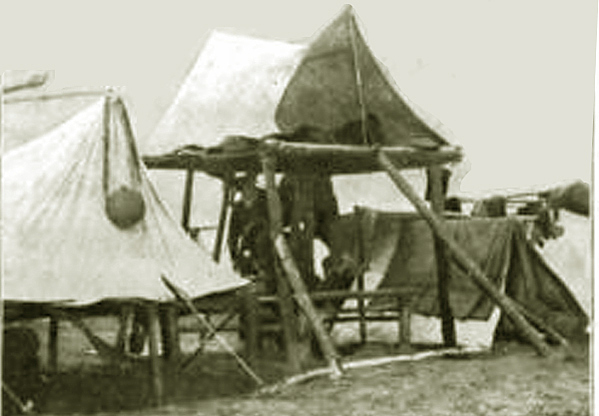
Camp Dewey, two story tent erected by two California Volunteers.
With the fall of Manila, things began to fall back into a routine. First Wyoming soon formed a baseball team and a band. Lt. Coburn was the pitcher. In the meantime, Aguanaldo's forces became less
friendly. At Cavite, it was noticed that on days that the insurgents were more active, Filipino employees were more likely to be absent. Thanksgiving came with
chicken for dinner. There were more instances of antics in the barracks. A favorite target was the first sergeant who disliked noise. Thereroe noise became louder and more
frequent. On Christmas day the South Dakota Volunteers invited First Wyoming over for a Christmas
banquet and program.
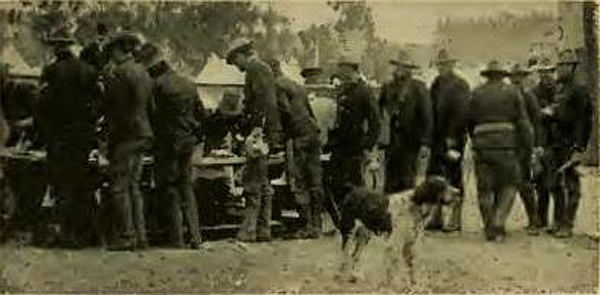
Mess at Camp Dewey.
On New Year's Eve an incident of "noise" arose which arried over to the Headquarters were the officers were quartered. battalion band and played the popular "There will be a Hot Time in the Old Town Tonight."
At the time, "Hot Time" was indeed popular. It was sung with much gusto by Theodore Roosevelt's Rough Riders in Cuba, that some
foreign observers who did not understand English believed it to be the American National Anthem. The song was the lead in for the NcIntire & Heath Minstrel Show.
Theodore Metz bandleader claimed that the song was as a result of watching
children attempting to light a fire in Old Town, Louisiana. It has, however, been claimed that the tune was more likely
appropriated from a song played by the "Professor" in a St. Louis bordello. The words were written by Joe Hayden. Theodore Roosevelt used it as his
campaign song during the 1904 presidential campaign. The officers and in particular Major Foote took it all with good humor.
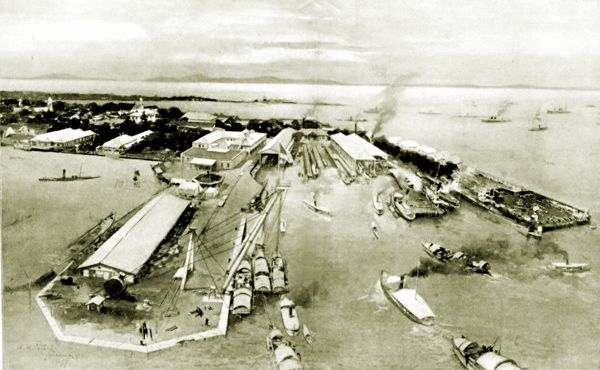
Bird's Eye view of naval base at Cavite showing, among other things, a sunken
Spanish vessel to the left of the long warehouse. Beyond the warehouse and the
octagonal structure is the Spanish Arsenal. See next photo.
On the right side of the wharf, cascos are being unloaded. On the lower right a tug is towing a
casco into the harbor.
The naval yard was very useful to Dewey. Following the sinking of the Spanish Fleet, the Naval Yard had been occupied by Aquinaldo. In July with additional troops antipated, the
Filipinos were requred to turn the facility over to the Americans. The naval yard
had a well equipped machine shop enabling repairs to be made.
It was protected by Fort San Filipe. It had an arsenal outside of which
were Spanish cannon. In addition, there were the Spanish barracks, and a prison. The officers were quartered in the
arsenal which had the only modern porcelain fixtures. In addition to the barracks, troops were housed in the prison and in three of the
Roman Catholic churches that formerly served the naval base. The fourth church was still used for services although the top of its
tower was blown off during Admiral Dewey's canonading of the base.
Col. Lippencott was less than impressed
with the quarters at Cavite".
[The] Troops[were] quartered in barracks, in the public buildings, and in old prisons. These buildings were found reeking with filth
and in a state of indescribable confusion and disorder from the
thorough looting of the Filipinos. The ground level of the peninsula
on which the arsenal and town of Cavite is situated is only a foot or
two above high tide, and the soil is very porous; yet each of the daily
rains leave the ground flooded with from 1 to 3 inches of water. The
entire peninsula is a sand bank with a top soil of several inches consisting
of the vegetable and animal debris of generations. One side is bounded by
a back bay (Bakor Bay) of dead water without tide race, and the sea wall
contains many recurrent angles designed for defense, but serving as catch
traps for all the offal and garbage thrown in the bay on that side.
The opposite side of the peninsula has a tide race, but the sea wall
throughout its greater extent is composed of the walls of Fort San Felipi [sic], made ground bordered
with defunct boilers and machinery from the navy-yard, and casemates
occupied at the date of the commencement of this report by about 2,500
Spanish prisoners in the hands of the Filipinos. The prevailing winds
are from the direction of Bakor Bay. in which lie a portion of the
destroyed Spanish vessels, the hulls of which contain the decomposed
bodies of many Spanish. This was evidenced by the seething and bubbling of
the water which filled the ventilating shafts, and the presence of
a stench which was plainly noticeable in Cavite.
There never was a sanitary drainage system in Cavite. The two or
three modern closets found had the gas vents carefully sealed and
discharged into sealed vaults, from which I have personally seen
explosions of gas drive the trap water out over the room. There was one
closet built over the sea wall with holes in the floor and blocks of
wood to keep the feet of the men out of the surrounding filth. In
the majority of the barracks, and in all the houses of the town, the feces
of generations had been carefully preserved in cemented vaults.
There were several more or less elaborate attempts at "improved sanitary
drainage." For instance: In the palace within the Cavite Arsenal the
officers' closets were modern porcelain affairs with a water flush, the water tank
requiring to be filled by hand and, with no gas vent to the trap.
Feces, urine, and water collected in a vault until the level of siphonage
was reached, when about two-thirds of the contents siphoned into a
sewer, which emptied through the sea wall at the level of low tide into
a recessed angle, where both wind and tide tended to retain all
accumulations of filth. This sewer, only periodically flushed as it
was, was connected by means of a grating in the floor with the inner
court of the building, so that all sewer gaa which was unable to enter
the building by way of the closets entered by way of the courtyard.
In other closets of the same class the siphon opened into a cesspool.
The palace of the Governor-General had an expensive cement arrangement
in which the rise and fall of the tide was expected to carry off the
feces through the medium of an open drain and a shallow dissolving vault.
There was an attempt at drainage of the surface water by the construction
of stone underground drains, but these were in most instances clogged or broken in.
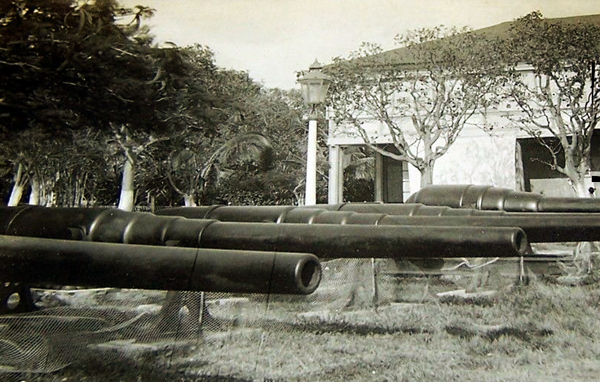
Spanish Arsemal at Cavite with cannons.
Insurgents under Emilio Aguinaldo's forces began to heat things up. The year before Aguinaldo had led an insurgency against the Spanish
which had been put down. Aquinaldo was exiled to Hong Kong with a promise of substanial money
from the Spanish. At first it had been hoped that Aquinaldo would be a help in defeating the Spanish. There was, however, a fear
that his followers would if allowed loot Manila. Nevertheless, Dewey brought him back from
Hong Kong. Aquinaldo had other ideas and declared independence. and formed a government. Thus relations between
the United States and Aquinaldo became strained. The United States did not believe that the Philippines were ready for independence
and was fearful that the islands would fall into the hands of the
Germans who had become more active in the Pacific. Germany had already occupied various lands in the Pacifc in addition to those
taken in Africa. In the Pacific the Islands taken by Germany included
the Bismarck Archipelago,
Northern Solomon Islands,
Bougainville Island,
A portion of New Guinea,
Nauru, Marshall Islands,
Northern Mariana Islands,
Caroline Islands and present-day Independent Samoa
Indeed, five German warships anchored in Manila Harbor following Dewey's defeat of the
Spanish fleet. The Germans were believed to be providing supplies to the
Spanish. Aquinaldo took possession of San Roque and made his headquarters there.
On January 2, First Wyoming was moved to the Cavite Naval Base which was now occupied by the Americans. The Wyoming Light Artillery had arrived from
San Francisco. Both the First Wyoming and the Wyoming Light Brigade were assigned to defend the causeway.
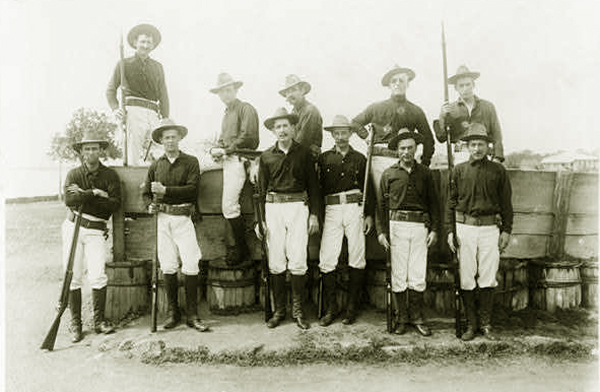
Outpost soldiers at Cavite.
The Light Brigade used four Gattling Guns to protect the causeway.
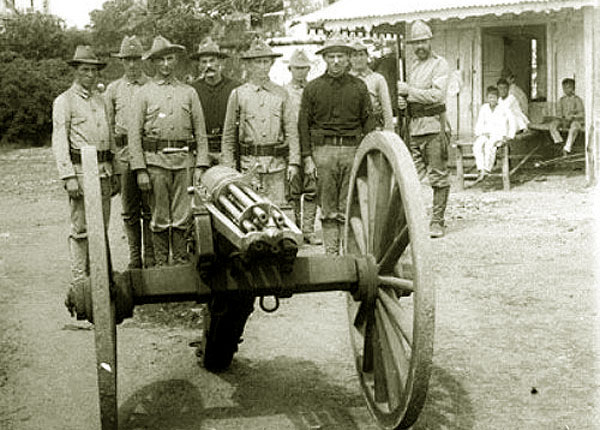
Gattling Guns stationed near entrance to causeway.
For nearly three hundred years,the Spanish centerpiece for the defense of Cavite was Fort San Filipe
constructed in 1609. The fort was consructed of granite and was pentagonal in shape
A ramp led up to the gun deck. Examples of
similar forts may be found in San Juan, Puerto Rico, and St. Augustine, Florida.
During American possession of the Philippines most of the fort except the portions of the
facade were razed.
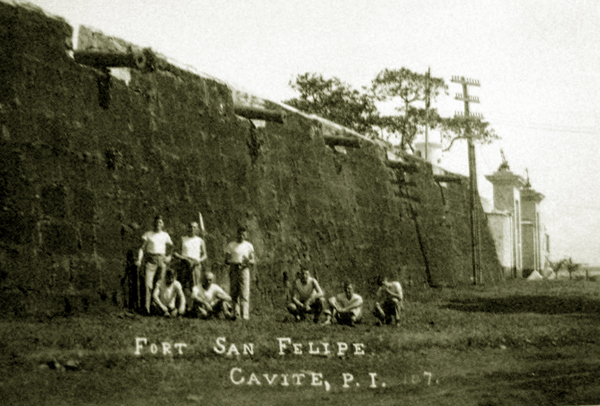
American Soldiers outside Fort Filipe.
On February 4, 1899, the difficulties with Aquinaldo boiled over. On February 4, Aquinaldo, in essence,
declared war on the United States. Much of the Spanish weaponry had fallen into his hands and most of the country-side was
occupied by Aquinaldo's insurgents. Additionally, some of the Filipinos that previously served in the Spanish
forces deserted to Aquinaldo. Aquinaldo occupied the town of Imus ten miles to the south
of Cavite in which was located a cartidge factory. Using materials that had been looted from
Cavite during his occupation of the naval yard, the insurgents operated the factory providing ammunition for the
their forces. On February 4, there was a general engagement between the Filipinos and American forces.
On February 9, the insurgents withdrew from San Roque and set the town on fire.
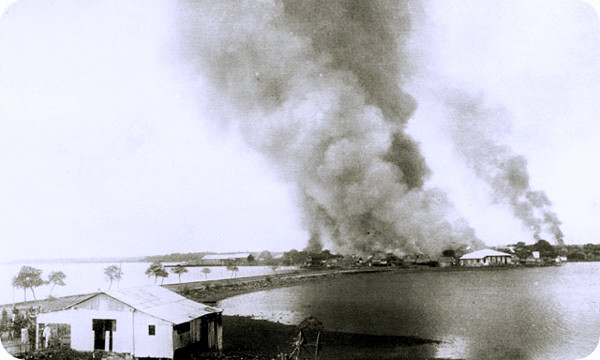
San Roque burning, Feb. 9, 1899.
The Wyoming light Artillery and infantry from other states gave pursuit. To avoit the flames the
troops circled around the town by way of the beach. Others fought the flames and managed to save a few of the important buildings.
The town was basically, however, destroyed. Many of the officers and men stationed at
Cavite had given their laundry to "banderos" (wash-men) in San Roque. After destruction as noted by Edwin Wildman in his
"Aquinalde, A Naritive of Filipino Ambitions," Lathrop Publishing Co., Boston 1901, p. 204, " a great many army and navy officers
were obliged to take an inconspicuous part in the fashionable afternoon parade on the Luneta." A few, however, were lucky. They had put
their landry with one bandero. "Some days after the smoke of the conflagration had cleared away,"
Wildman wrote, "an the erstwhile insurrecto reappeared at his native town in the dress of an amigo, many American officers were
treated to a surprise by the return of their apparel neatly laundered. Upon questioning how the miracle
was performed, the bandero related that when the town was burned he had
pitched the wash into the nearest well, where it had remained uninjured and unmolested during the fight and fire." The town was subsequently rebuilt but not to
its previous size. E. J. Grown, a naval surgeon writing in the 1904 Annual Report of the Surgeon General, United States Navy, referred to
San Roque as a "hell hole" of social diseases. By 1921, the administration of the islands eliminated
the facilities in which the social diseases were spread.
Music this Page:
There will be a Hot Time in the Old Town Tonight
Composer: Theodore A. Metz
Lyrics Joe Hayden
Come along get you ready, wear your bran, bran new gown,
For dere's gwine to be a meeting in that good, good old town,
Where you knowed ev'ry body, and they all knowed you,
And you've got a rabbits foot to keep away the hoodoo;
Where you hear that the preaching does begin,
Bend down low for to drive away your sin
And when you gets religion, you want to shout and sing
There'll be a hot time in the old town tonight!
My baby -
Chorus:
When you hear dem a bells go ding, ling ling,
All join 'round and sweetly you must sing
And when the verse am through, in the chorus all join in,
There'll be a hot time in the old town tonight.
Verse 2:
There'll be girls for ev'ry body in that good, good old town,
For dere's Miss Consola Davis an dere's Miss Gondolia Brown;
And dere's Miss Johanna Beasly she am dressed all in red,
I just hugged her and I kissed her and to me then she said:
Please, oh please, oh, do not let me fall,
You're all mine and I love you best of all,
And you must be my man, or I'll have no man at all,
There'll be a hot time in the old town tonight!
My baby -
Chorus
Next page: First Wyoming and Wyoming Light Artillery in the campaign south of Manila and return home.
.
|